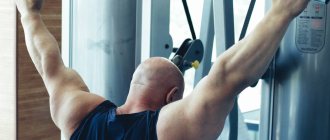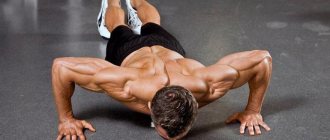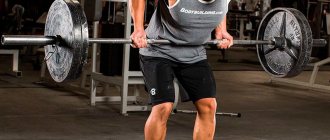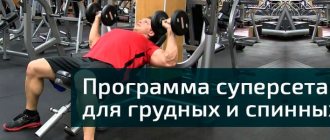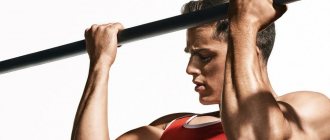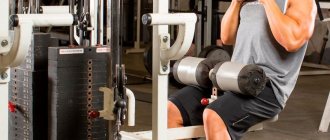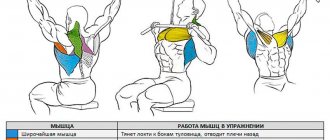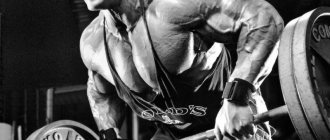Pull-ups behind the head are often used as a way to diversify the usual pull-ups on the horizontal bar and additionally work the back. Of course, you should only include this exercise in your training program if you have already mastered the classic version well and are ready for further complications and experiments.
It is also important to consider that if the technique is not followed (especially if there are contraindications), the exercise can be traumatic. But first things first.
What muscles work
Pull-ups by the head work out almost the entire upper back (just like regular pull-ups on a horizontal bar), namely:
- latissimus dorsi muscles;
- rhomboid muscles;
- teres major muscle.
Some athletes note that pulling up behind the head puts a good load on the teres dorsi muscle, which is not so easy to work under other conditions. Additionally, the work includes the pectoral muscles, biceps, and shoulders.
Benefits and harms
The benefits of pulling up by the head are obvious: due to a more even position of the body, the load is almost completely focused on the large round muscles of the back, which in the long run will visually make the back wider. Also, working with your own weight makes your ligaments and tendons stronger. Due to the constant static load on all the muscles of the back, the relief greatly improves, with each week the back becomes more and more lumpy and well-developed.
However, this exercise also has disadvantages associated with the individual anatomical characteristics of the body or incorrect technique for performing the exercise. Let’s look at them in more detail, since they pose a potential danger to the athlete’s health.
Flexibility in the shoulder joints
Many athletes simply do not have enough flexibility to properly perform head pull-ups on a horizontal bar. The fact is that due to a sedentary lifestyle, all office workers have a severe deterioration in posture and flexibility in the shoulder joints. This prevents you from doing exercises such as pull-ups and rows of a vertical block behind your head or bench press while sitting behind your head. In medicine there is even a special term for this problem - “computer neck” syndrome. It is expressed in the fact that a person who spends 6-8 hours during the working day in front of a computer constantly has his head stretched forward, the thoracic spine is twisted, and his shoulders are tilted down and forward. Over time, this problem becomes chronic, and posture noticeably worsens. Of course, you won’t be able to do pull-ups normally like that. It is imperative to work on flexibility, otherwise this simple exercise may result in injury for you.
Attention to the cervical region
The next potential danger is in the neck. I don’t know where this came from, but every second athlete, while doing pull-ups, considers it his duty to throw his head back as much as possible. They say to better focus on the work of the latissimus dorsi muscles. However, as you understand, there can be no relationship between the neuromuscular connection and head position. However, throwing your head back will cause excessive tension in your neck muscles. In turn, this often ends in neuralgia of the cervical spine or occipital nerve.
People with back problems should be especially careful when performing pull-ups with a reverse grip. This can bring not only benefits, but also harm; it can easily aggravate existing diseases. Athletes suffering from hernias, protrusions, scoliosis, kyphosis, osteochondrosis and other diseases need to obtain detailed recommendations on the training process from their doctor before starting training.
Exercise with weights
And lastly, there is no need to do this exercise with additional weight. I understand that you may feel that you are strong enough for this, but it’s better not to. The fact is that the rotator cuff is the most easily injured area of our body, and the tension on it increases significantly when using additional weights. Recovery from injury may take several months. It is better to do pull-ups with a reverse grip for a greater number of times or reduce the rest time between approaches, this will be much more beneficial.
Wide or narrow grip?
By default, we mean wide-grip pull-ups. In general, there is an opinion that the wider the grip, the higher the effectiveness of the exercise. This is only partly true. It is important to maintain balance here, since an overly wide grip can lead to injury to the shoulder joints.
Choose the optimal grip width carefully. The main indicator is a feeling of tension in the working muscles and the absence of discomfort, a feeling of “pinching” of the shoulders or back.
Narrowing your grip tends to shift the load from the top to the bottom of the latissimus dorsi, and also involves more of the pectoral muscles and arms. In other words, the back is less loaded, so most often a narrow grip when performing this type of pull-up is not recommended due to its specificity and increased risk of injury (for example, sprain). Use a narrow grip only if you have extensive experience with the horizontal bar and have individual training goals.
Who should not do these exercises?
If you have ever had diseases associated with the cervical spine or shoulder joint, then we do not advise you to resort to this approach, since it is in these areas that serious stress occurs.
Do not try to immediately take the widest possible grip, as this again risks injury. First, try a grip slightly wider than shoulder width, and then monitor your own sensations and adjust your movements if necessary.
Correct technique
Head pull-ups are performed as follows:
- Starting position: hang with a wide grip on the bar. The selection of the optimal grip width was discussed above. Initially, you can try a grip slightly wider than shoulder width (about 20 centimeters). Hang on the horizontal bar with relaxed straight arms so that only your forearms remain tense, take a deep breath.
- As you exhale, gently pull yourself up, straining your lats, so that the middle of the back of your head is at the top point at the level of the bar. At the same time, the elbows are not pressed against the body, so as not to reduce the amplitude of contraction and not to reduce the effectiveness of the exercise.
- Just as smoothly, while inhaling, lower yourself to the starting position. Do the required number of repetitions.
Some athletes recommend holding at the top point, taking an extra breath, and then lowering to the starting position as you exhale. But more often, pull-ups on the horizontal bar still involve a more common option - inhale in the starting position, exhale during the rise, inhale when we go down (without interrupting breathing).
The number of repetitions depends on your preparation. It is optimal to start with 2 sets of 5-6 repetitions, gradually increasing their number.
How to properly perform the head pull-up exercise:
- Take the bar with a wide grip and hang on it for a while to make your back muscles more flexible.
Attention! You need to do pull-ups in a relaxed state, giving the load to your forearms for a strong grip.
- When you bring your shoulder blades together, you need to move your body a little forward so that you are exactly under the horizontal bar.
- After this, you need to take a deep breath, hold your breath for a few seconds, tense your back muscles and begin to pull yourself up.
- When you lift your body, you need to put your head behind the bar, raising it to the level of your neck.
- At the top you should stop for a moment so that the muscles begin to contract.
- As you pull yourself up, exhale, slowly lowering your body down and drawing in air again.
Do the exercise as many times as you planned
However, not everyone will be able to do the exercise, since it is difficult to achieve the full amplitude. Each person needs a different approach: if you feel pain in your shoulders, then you should reduce the amplitude so as not to harm your health.
What else is important to consider?
When pulling yourself up by your head on the horizontal bar, be careful not to excessively “hunch over.” At the top point there is a desire to unload the lats and hunch over, easing the load. We keep our head as straight as possible, with our shoulder blades pulled together.
Try to lower yourself to the starting position smoothly and do not throw your body sharply down. Lower yourself, controlling the movement and feeling the muscles working. Thus, in addition to increasing the effectiveness of the exercise, you will protect yourself from injuries to the shoulder joints.
It is important to maintain a full range of motion. Lower yourself to the end, when your arms are straightened, rise on the horizontal bar to the top point until the crossbar is at the level of the back of your head.
Think of your arms simply as “mounts” that hold you on the horizontal bar; do not include your biceps in the work, because our goal is to work your back.
As a result, we can say that head pull-ups are a very specific exercise that makes sense to include in training for athletes who are not new to the horizontal bar and have some experience. For beginners, it is advisable to first master the technique of classic pull-ups.
The main secrets of the exercise
Raising your head with a wide grip should be performed taking into account the following nuances:
- Make a grip of such a width that at the peak (at the top) your forearms are parallel (or in other words, perpendicular to the floor).
- Try not to spread your arms too far. Otherwise, the amplitude decreases and the lats are unloaded. It is ideal to find a middle ground when the amplitude is sufficient to work the muscles.
- When doing pull-ups, try not to hunch over . It is important. This is not difficult to do - just bring your shoulder blades as close to each other as possible. There are people who cannot do pull-ups like this due to lack of mobility in their shoulders. Therefore, if you are hunched over, you may want to avoid doing this type of exercise in favor of a regular movement toward the chest.
- Pull-ups are a basic exercise designed to work the latissimus muscles. Therefore, if your goal is to achieve a wide and powerful back, then it is worth including in your training program.
- If you can’t pull yourself up even once, then you should hire an assistant. It will help you rise to the required level (you can also use a gravitron).
Such different pull-ups...
But first, let’s make an important note: which muscles will work during the exercise directly depends on the type of grip chosen by the athlete. Thus, with just one exercise (but in different variations) you can train different muscle groups and ligaments. Comprehensive muscle development contributes to a rapid increase in strength, muscle mass, endurance and other athletic performance. In addition, it provides a powerful anabolic boost to the body.
Results
This type of pull-up works great for the upper back. In this case, the maximum load falls on small muscle groups. This also includes the teres muscle, which naturally receives little load.
Effectiveness can be achieved if you do the exercise with a wide grip and slowly. In this case, it is important to ensure that your elbows “look” to the sides. If you do not follow this rule, then the biceps, deltoids and trapezius muscles will be involved in the work, which is a serious mistake.
You shouldn't use a very wide grip. There is another rationale for this recommendation. In this case, the shoulder joints become loose. Subsequently, problems may arise with the bench press and other exercises.
And lastly, if you are new to the gym, start with classic wide-grip pull-ups to the chest. As for more serious variations, they should be left for the future. At the initial stage, three sets of six to ten repetitions are enough. Afterwards the number of sets can be increased to four. When the number of repetitions reaches 15, additional weights are allowed.
Anatomy exercises
Pull-ups are one of the most accessible and effective exercises for strengthening muscle groups of the upper body: latissimus, biceps, brachialis, upper back, forearms, rectus abdominis (abs).
The latissimus muscle - the largest muscle of the body - originates from the armpits and, covering the lower corner of the shoulder blade, falls down, forming a “wing”. This muscle is responsible for bringing the elbows to the body in the vertical and sagittal planes (the plane of human symmetry). The latissimus muscles are not only the largest muscles of the back, but also the most “responsive” - they are the first to increase during strength load. Pull-ups on the horizontal bar are considered the basis for these muscles.
Next to the latissimus is the teres major muscle, which helps in bringing the elbows toward the body and pulling the shoulders back. Above the latissimus are the trapezius muscles. They are responsible for all movements of the shoulder blades, including “assisting” the rest of the muscles when extending the arms in the horizontal plane. Hidden under the trapezius muscle is the rhomboid muscle. All of these muscles are involved in doing pull-ups. The back extensor muscles, which are responsible for straightening and stabilizing the body, also receive a share of the load. In pull-ups, they are loaded to stabilize the spine.
When pulling up, almost all back muscles are involved in the work. The rotator cuff also works, and the fingers and hands are strengthened. The exercise strengthens the abs, which is also involved in stabilizing the position of the body in space, and the hips.
Pull-ups are an effective exercise for strengthening the biceps because... comprehensively trains it through the movement of two joints - the elbow and shoulder. This exercise will help not only significantly increase muscle mass, but also develop the functional strength of the trainee.
Regular pull-ups have a healing effect, work out the muscle corset and protect the back from injury, strengthen the posterior deltoid muscle of the shoulder. The correct technique strengthens the joints, which other back exercises cannot do.
Another nice bonus: pull-ups are the safest way to strengthen your back. The secret is that nature itself has incorporated the pull-up mechanism into the human body. Therefore, trainers and sports doctors recommend pull-ups even for those who have health problems. Thus, pull-ups are often included in the training program for people with musculoskeletal problems, since the exercise engages the spinal stabilizer muscles, which are responsible for the formation of posture. The main thing when performing all movements is to monitor the technique and gradually increase the load. Note: by changing the width and method of grip, you can influence different muscle groups. So, a reverse grip gives a good load on the biceps. Medium-grip pull-ups work the biceps, trapezius, and latissimus muscles. A wide grip better works the top of the lats, trapezius and round muscles of the back, while a narrow grip works the shoulders and the bottom of the lats. You can read more about grips in a separate article.
Sequential horizontal row exercises[edit | edit code]
Horizontal row exercises
often considered as a build-up exercise before moving on to the vertical row. However, they are also rightfully separate independent exercises. Because you move in different planes, the trajectory of your movement forces your muscles to work at different angles. The Australian pull-ups presented below are in the program of any trainee, even if he is able, now or later, to perform vertical pull-ups while hanging on a horizontal bar.
Australian Pull-Ups[edit | edit code]
Main article:
Australian pull-ups
Australian pull-ups
This is a great technique for allowing beginners to progress to full pull-ups in workouts, but it can be useful for people of any skill level. Remember that Australian pull-ups are a little different from regular pull-ups, so it's good to have them in your arsenal and do them periodically as they are a very special exercise.
Beginners should initially do this with a bar at waist height, but as they progress, they should use progressively lower bars to reduce leverage. Eventually you will have to place your feet on the second bar so that your body is at a more obtuse angle to the ground - this will complicate the task. You can also experiment with plyometric variations of Australian pull-ups and explosive movements, changing your grip from forward to reverse between reps or changing your grip width. There is always a way to make a basic exercise more difficult.
Which grip to choose for beginners and experienced athletes
Pull-ups are a fairly difficult exercise. It is not easy for beginners to master immediately; mastering it in its “pure” form can be difficult, so trainers often advise starting classes with additional equipment - a gravitron or expanders. They make the exercise easier by “taking” part of the load onto themselves.
How to place your hands on the horizontal bar? Best of all - slightly wider than shoulder level with a reverse grip (fingers of the palms “look” at you). “When doing pull-ups with a direct grip, the brachioradialis muscle is activated to a greater extent, and when doing pull-ups with a reverse grip, the biceps is activated,” reminds Alexey Bolyaev. — Therefore, beginners should start with pull-ups with a reverse grip, since the auxiliary muscle in these exercises is the biceps, which is a priori larger and stronger than the brachioradialis muscle. This way, reverse grip pull-ups will be easier.”
Having mastered this type of pull-up, you can move on to others - for example, perform exercises with a straight grip. “A direct grip should be used by more trained athletes even if the load is intended to be directed to a greater extent on the back muscles,” says Alexey Bolyaev.
Do you want to increase the load? Try doing pull-ups with a narrow or wide grip, using weights (belt, weight), changing the position of your legs (throwing them up), etc.
Contraindications and restrictions for working on the crossbar
Many people mistakenly believe that all exercises on the horizontal bar can be performed without any restrictions. This is wrong. Even a prosaic hang on the bar without safety loops can be harmful to health. Contraindications for exercise include:
- heart failure;
- obesity of varying degrees;
- congenital pathologies of the spine;
- spinal deformity (scoliosis);
- protrusion and intervertebral hernia.
People who have just undergone treatment for sprains and torn ligaments in the elbows, wrists, and shoulder girdle should not rush to the horizontal bar. Most likely, you should first normalize your weight using other sets of exercises or diets. And only then start doing pull-ups on the bar.
Pull-up workout program
| Level 1 | Australian pull-ups | 2 sets of 20 reps |
| Level 2 | Pull-ups with elastic band | 2 sets of 20 reps |
| Level 3 | Negative pull-ups | 3 sets of 10 times |
| Level 4 | Wide grip pull-ups | 3 sets of 10 times |
| Level 5 | Medium grip pull-ups | 2 sets of 10 times |
| Level 6 | Close grip pull-ups | 2 sets of 10 times |
| Level 7 | Diagonal pull-ups | 2 sets of 9 times |
| Level 8 | Australian one-arm pull-ups | 2 sets of 8 times |
| Level 9 | One-arm pull-ups with support | 2 sets of 7 times |
| Level10 | One arm pull-ups | 2 sets of 6 times |
Inclusion in the training plan
During the training process, pull-ups are basic exercises - this can be seen from what muscles are working. Therefore, when doing a full-time workout, you should start with the horizontal bar. For example , a complex aimed at building a powerful and wide back :
- Pull-ups . A beginning athlete can do the minimum available number of repetitions and approaches. An experienced athlete should complete up to 50-60 repetitions (4-6 approaches) per workout. For a more natural workout of the core muscles, it is possible to alternate between classic pull-ups on the horizontal bar and complex pull-ups behind the head.
- Dumbbell row to the waist . You can supplement this by pulling a barbell to your waist. Exercises are performed after pull-ups to consolidate the results. For a normal load on the body, 3 sets of 8-10 repetitions are enough. Working weight - no more than 3/4 of the maximum.
- Upper block thrust . This exercise replaces pull-ups if for some reason the athlete is unable to perform high-quality work with the bar. The effect is slightly lower than when exercising on the horizontal bar. Scheme - 3 sets of 8-12 repetitions.
The point of pull-ups is that they are the main exercise for strengthening and creating a broad back. Everything else can be called “supplementary” elements in the training program. The accessibility of the horizontal bar and relative safety when working with body weight allows you to create beautiful and properly strengthened back muscles. Due to its specificity, a smooth entry will be required; exercises for the head will be easier with experience in regular pull-ups.
